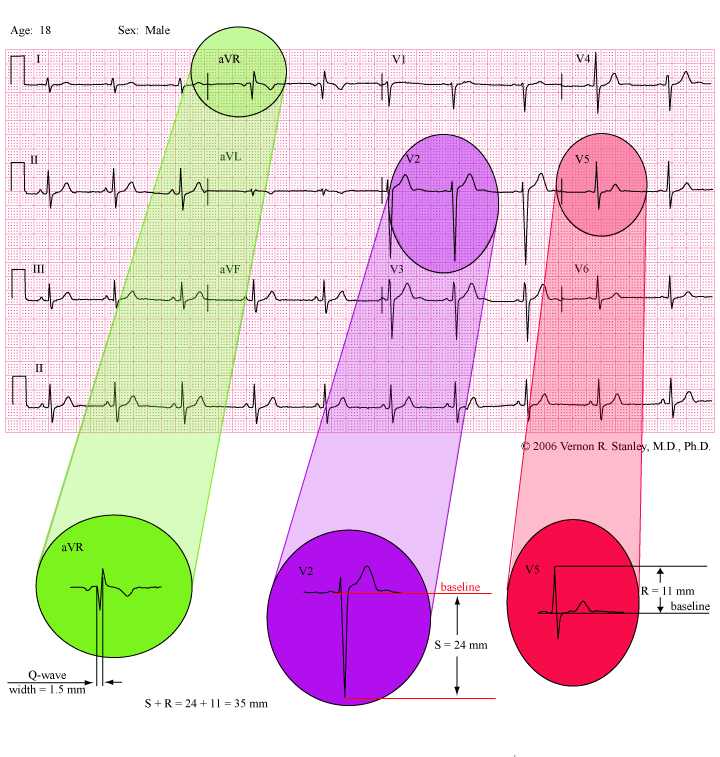INTERPRETATION: NORMAL ECG
DISCUSSION:
I have included this 12-Lead in this Case Study as well as the clinical scenario because of several teaching points.
I have specifically circled and magnified 3 leads and will discuss the salient point of each lead below.
1……….Although Lead aVR contains the least useful information of the 12-Leads, it is important to be aware of its typical characteristic. I have magnified Lead aVR and labeled the Q-wave as 1.5 mm wide. Please carefully examine the whole complex P-QRS-T colored green and note the following:
First———The QRS complex is usually dominantly negative.
Second—–The QRS complex often has a significantly wide Q-wave (>0.04 sec or 1mm).
Third——–The T-wave is usually inverted
Fourth—–The P-wave is usually inverted
These four characteristics are typical features of the NORMAL Lead aVR complex.
2…….. The criteria of LVH as listed in my textbook and HEART rule does not apply to the young patient(it only applies for age >35 years). The focus for LVH is V1,V2, and V3 (rightmost precordial leads), AND V6,V5, and V4 (leftmost precordial leads). As per my HEART rule we also examine Lead aVL
a….. R + S > 35 mm (precordial leads) where ——
R = tallest R-wave of Leads V6,V5,V4
S = deepest S-wave of Leads V1,V2,V3
………………………………………..and/or
b….. R > 12 mm in Lead aVL
CONCLUSION and PEARL:
Teaching Point # 1
This tracing contains a classic configuration of Lead aVR. Please scroll back up and study the shape, configuration, polarity,T-wave inversion, inverted P-wave of this complex.
When analyzing a given tracing, if it does not look similar to this one, you should consider a common possibility.
Limb Lead misplacement.
e.g. if electrode avR is placed on the left arm and aVL is placed on the right arm, the Limb leads will clearly assume a reversed shape.
Teaching Point # 2
Before measuring for LVH, be sure and check or ask for the patient’s age—
If they are young, the LVH voltage criteria does not apply, so don’t bother looking for it.
You will frequently see the following expression on the cardiologist’s or computer interpretation :
“The tracing satisfies the voltage criteria for LVH, but it may be normal for stated age.”
A misdiagnosis of LVH not only may effect the treatment mode, but also can become a catastrophic negative injected into the patient’s medical record.

